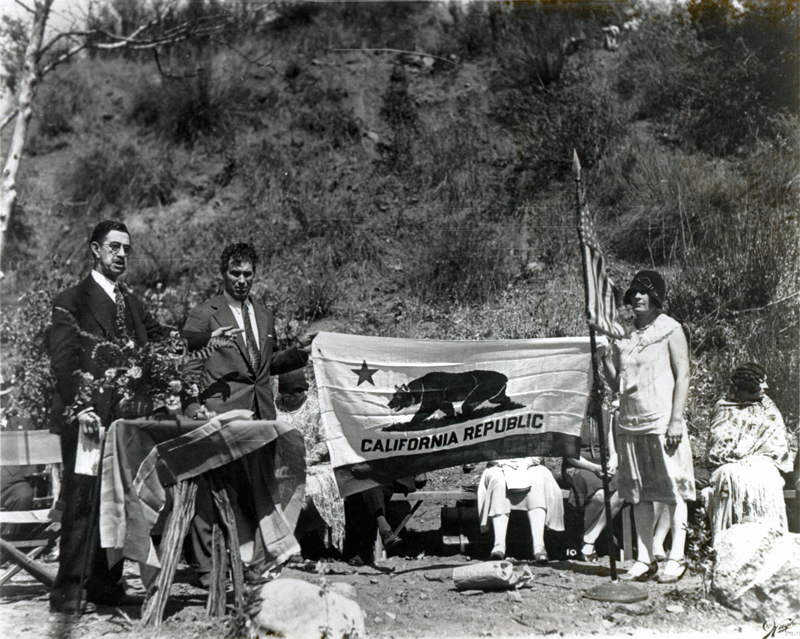|
|
Placerita Canyon

Click image to enlarge Adolfo G. Rivera (left), master of ceremonies at the March 9, 1930, dedication of Francisco Lopez's 1842 gold discovery site in Placerita Canyon, presents the California state flag to Placerita property owners Frank and Hortense Walker. During the ceremony, Rivera proclaimed: "We of this Southland do now inform the historians of the North and announce to the world that we proclaim our right to be recognized in the history-making epochs of our state, that this [Francisco Lopez's] discovery must be presented in the textbooks in our schools, and we advise legitimate writers on California history to take heed, or they will be branded as falsifiers and concealers of the truth." (See Scorza & Wright 1926-1976:12). Judging from photographs, about 300 people attended the dedication ceremony. Recognition of the Lopez discovery was, and to some degree still is, a challenging thing to attain. It occurred six years prior to the much more famous discovery on the South Fork of the American River at Sutter's Mill, but the latter overshadowed it because the Sutter's Mill discovery was the first big American discovery of gold in California. When Lopez discovered gold in Placerita Canyon in 1842, the canyon, and the rest of Alta California, was still a part of Mexico, so it was really "just another discovery" of gold in Mexico, not much different from other discoveries in more southerly parts of that country. The identity of the Oak of the Golden Dream in Placerita Canyon State Park as "the" tree where Francisco Lopez napped and dreamed of finding gold (which he did) in 1842 was not set in stone — literally or figuratively — until nearly a century later, in 1930, by Frances Lopez de Belderrain, a Lopez descendant. Belderrain (alternately Francisca Lopez de Balderain) had learned the story from Catalina Lopez, who was in her 80s when she shared the information with family members from memory. According to Adolfo G. Rivera, who presided at the 1930 dedication of the tree, Catalina would have been 12 years old when she attended an 1843 ceremony marking the one-year anniversary of the Lopez discovery, whereupon she learned learned the relevant locations. In a promotional brochure published by 1930s Placerita landowner Frank Walker, Rivera writes in part: "The first anniversary [in 1843] of this gold discovery was celebrated by the erection of a chapel on the site of the discovery and the chanting of a solemn high mass by three priests, two from San Fernando and one from Los Angeles, six altar boys, the entire Mission choir, consisting of twenty neophytes and eight musicians. Many prominent families of Los Angeles, Santa Barbara, San Buena Ventura and the surrounding country and the Commissioners sent by Mexico to investigate the truth or falsity of the discovery, were present, — a date in the history of our State was solemnized, which was to be forever after forgotten. "Catarina [sic] Lopez, wife of Geronimo Lopez, was eleven years old when gold was discovered here and was present at the celebration of the mass in 1843. Before her death she took several members of her family to Placeritos Canyon and pointed out to them the exact spot where the chapel had been erected and gold discovered by her ancestor. In this party were the Señoras Frances Lopez de Belderrain, and Graciosa Lopez de Wilson of San Fernando and these kind ladies have in turn shown the writer the self-same spot of FIRST GOLD DISCOVERY IN CALIFORNIA." Read Rivera's entire story and see the Walker brochure here. Whatever the truth of the dream legend or the accuracy of the tree's identification, Lopez and his partners did extract gold from Placerita Canyon in 1842 and did file a claim with the Mexican governor of Alta California — and that piece of parchment, with the governor's seal of approval, is what makes the Lopez discovery the first documented discovery of gold in California. Earlier discoveries in the Castaic and Piru region appear in 19th-century literature, but in each case, the documentary evidence is lacking. In a joint effort of fraternal organizations — Ramona Parlor No. 109 of the Native Sons of the Golden West, the La Mesa Club and the Kiwanis Club of Newhall-Saugus — a plaque was placed on March 9, 1930, the 88th anniversary of the Lopez discovery, at the site of the tree that is now recognized by the state of California as the Oak of the Golden Dream.
AP1407: 19200 dpi jpeg from copy print. |
Belderrain Story 1930
Belderrain Affidavit 2/23/1930
Walker Affidavit 3/1/1930
Event Program 3/9/1930
Rivera's Speech 3/9/1930
Sen. Del Valle's Speech 3/9/1930
Perkins' Speech 3/9/1930
Panorama 3/9/1930
Dedication 3/9/1930
Dedication 3/9/1930
Tree Plaque 1930
Lopez Plaque 1930 x2
Van Nuys News 4/25/1930
Correspondence 1934
|
The site owner makes no assertions as to ownership of any original copyrights to digitized images. However, these images are intended for Personal or Research use only. Any other kind of use, including but not limited to commercial or scholarly publication in any medium or format, public exhibition, or use online or in a web site, may be subject to additional restrictions including but not limited to the copyrights held by parties other than the site owner. USERS ARE SOLELY RESPONSIBLE for determining the existence of such rights and for obtaining any permissions and/or paying associated fees necessary for the proposed use.













